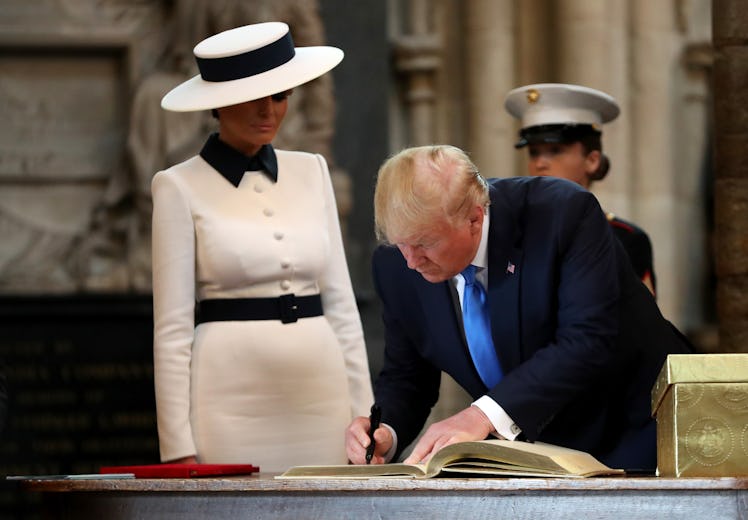
Trump Is Rolling Back Clean Water Protections, Because Who Needs To Drink Anyway
Since April 2019, the Trump administration has already proposed a repeal on carbon emission limits, looser methane standards, and changes to Obama-era coal regulations. This time around, the Environmental Protection Agency (EPA) is tackling water pollution protections. In his next environmental move, President Donald Trump will roll back clean water regulations first implemented in 2015, per The New York Times.
On Sept. 12, the Trump administration finalized a rule to replace the Waters of the United States rules — or WOTUS, for short. When the Clean Water Act was first passed in 1972 to regulate water pollution, it was unclear which bodies of water were actually being protected. So, in June 2015, President Barack Obama, the EPA and the Army Corps of Engineers passed WOTUS with the goal of defining a bunch of arbitrary terms — like ponds or tributaries — to provide the "clarity and certainty businesses and industry need about which waters are protected by the Clean Water Act," according to Vox. The rule gave the federal government oversight of pollution regulations in both large bodies of water and smaller ones like streams and wetlands. Under the regulation, farmers working near these smaller bodies of water were restricted from certain kind of plowing and types of crops, and are required to get permits for certain types of pesticides that could run off into those bodies of water, per The New York Times.
Now, Trump is revising those definitions, returning the regulations to the pre-2015 definitions, and reducing federal oversight over some of those bodies of water. The White House did not immediately respond to Elite Daily's request for comment. In a press release, the EPA described the change as "ending a regulatory patchwork" created by the rule. “Today, EPA and the Department of the Army finalized a rule to repeal the previous administration’s overreach in the federal regulation of U.S. waters and recodify the longstanding and familiar regulatory text that previously existed,” EPA Administrator Andrew Wheeler said in the release. The change will go into effect 60 days after publication in the Federal Register.
Obama’s regulations were meant to limit pollution in about 60% of bodies of water in the United States or a third of the population’s potential drinking water. While the Obama administration simply perceived this to be a largely technical change, opponents — including farmers and governmental conservatives — saw it as government overreach preventing land owners from making their own property decisions, per Vox.
Trump’s WOTUS replacement reflects those cynicisms, and the announcement shouldn’t come as any surprise. He has been eyeing the regulations since entering office, echoing farming advocates' concerns that Obama’s rules “overstepped the limit of protecting clean water” by regulating land use, per The New York Times. In January 2018, former EPA Administrator Scott Pruitt suspended the policy for two years. In a press release, he said the EPA would develop changes providing "regulatory certainty" to Obama's more confusing rules. Almost a year later, in December 2018, the EPA proposed revised definitions of “waters of the United States,” which it said would save costs, protect waters, and reduce barriers to business growth.
Marking the finish line to his WOTUS battle, Trump’s replacements will reduce the number of waterways and streams protected by the federal government. The New York Times reports the changes are expected to affect wetlands not directly connected to major bodies of water and "ephemeral streams," or streams that only have water during or after rain. The government will no longer have the oversight to regulate pollution into these certain areas. This would be the president’s fiftieth environmental rollback, and his fifth specifically about water regulation.
The changes are particularly eyebrow-raising considering that many Americans don't even have currently have access to clean drinking water. In Flint, Michigan, the ongoing water crisis has left residents dealing with lead-contaminated water for years, and nearly five years after tests first reported high lead levels in the drinking water, residents remain concerned. Similar problems continue to threaten other American cities, such as reports of fertilizer chemicals in water in California, and lead in Newark, New Jersey.
On Sept. 12, EPA Administrator Wheeler claimed in a Des Moines Register op-ed that Obama over-expanded Washington’s power over states and private property, and touted the new law as a way to reduce legal gray space while improving the economy. Jon Devine, director of federal water policy at the National Resources Defense Council, could not disagree more. In a statement on Sept. 12, Devine claimed the Clean Water Rule represented “solid science and smart public policy." "The Trump administration’s wild-eyed attempts to reward polluters, however, knows no bounds," he wrote, and said it would be challenged in court.
Though the replacement may go into effect within weeks, it probably won’t cause huge changes just yet, with Obama-era regulations on hold in many states, per Politico. The EPA is taking public comments for the next 60 days.
With ongoing water crises, access to clean drinking water has been a central environmental concern throughout Trump's time in office. While we have to wait to see how much water will actually be impacted by these new rules, this definitely poses concerns for environmentalists. Especially when we don't know what kind of rollback will come next.